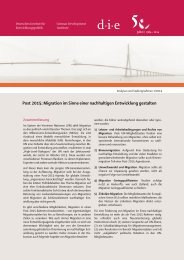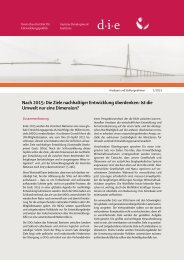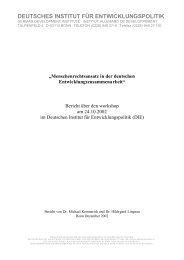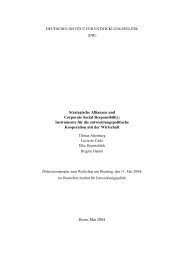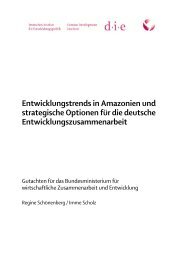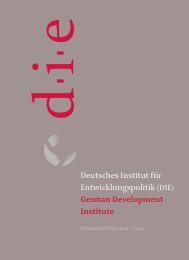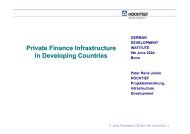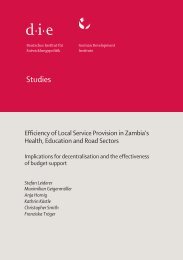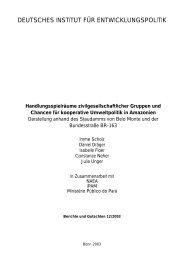Middle East / North Africa and the Millennium Development Goals ...
Middle East / North Africa and the Millennium Development Goals ...
Middle East / North Africa and the Millennium Development Goals ...
Create successful ePaper yourself
Turn your PDF publications into a flip-book with our unique Google optimized e-Paper software.
Five groups of capabilities can be distinguished:<br />
– economic capabilities (on <strong>the</strong> basis of income <strong>and</strong> assets),<br />
Markus Loewe<br />
– human capabilities (health, education, <strong>and</strong> access to food, water, <strong>and</strong><br />
habitation),<br />
– political capabilities (freedom, voice, influence, power),<br />
– sociocultural capabilities (status, dignity, belongingness, cultural<br />
identity), <strong>and</strong><br />
– protective capabilities (protection against risks).<br />
The HDRs, which have been released annually since 1990, seek to measure<br />
some of <strong>the</strong>se capabilities with <strong>the</strong> Human <strong>Development</strong> Index (HDI).<br />
The HDI is a composite indicator of prosperity that includes, for <strong>the</strong> population<br />
of a given country, per capita income (as <strong>the</strong> key figure for economic<br />
capabilities) <strong>and</strong> data on levels of education <strong>and</strong> health (as criteria<br />
for human capabilities) (El Masry 2003, 472).<br />
The disappointing balance of development in <strong>the</strong> 1980s also led to <strong>the</strong> calling,<br />
in <strong>the</strong> early 1990s, of a number of international conferences in <strong>the</strong> UN<br />
framework that dealt with various aspects of social <strong>and</strong> ecological development<br />
(see Overview 2). The first of <strong>the</strong>se conferences was <strong>the</strong> 1990<br />
Summit on Education for All in Jomtien (Thail<strong>and</strong>), which was organized<br />
by UNESCO; at it <strong>the</strong> international community defined a number of educational<br />
goals, including an important one calling for access, for all children<br />
– girls <strong>and</strong> boys alike – by <strong>the</strong> year 2000, to a complete course of<br />
primary education. This conference was followed by <strong>the</strong> World Summit<br />
for Children in 1990 in New York <strong>and</strong> <strong>the</strong> ‘Earth Summit’ in Rio de Janeiro<br />
in 1992, which adopted four l<strong>and</strong>mark declarations. One conference<br />
of particular importance for what was to come was <strong>the</strong> 1995 Copenhagen<br />
World Summit for Social <strong>Development</strong>. Among o<strong>the</strong>r things, <strong>the</strong> conference<br />
adopted a 10-point Declaration on Social <strong>Development</strong> that later<br />
formed <strong>the</strong> basis of <strong>the</strong> MDGs.<br />
These world conferences were as such nothing really unprecedented. Earlier<br />
decades had also experienced some international conferences that<br />
adopted declarations of intent <strong>and</strong> commitments on various issues. What<br />
was new, however, was (i) <strong>the</strong> large number <strong>and</strong> close sequencing of <strong>the</strong><br />
world summits, (ii) <strong>the</strong> detailed <strong>and</strong> binding character of <strong>the</strong> resolutions<br />
adopted, <strong>and</strong> (iii) <strong>the</strong> high political importance attached to <strong>the</strong> conferences.<br />
28 German <strong>Development</strong> Institute



